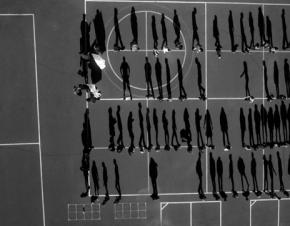We see you seeing us
looks at photos that are worth a thousand words about Big Brother.
WATCHING YOU, Watching Me is an exhibition of photos that expose how pervasive, creepy and intrusive the modern surveillance state has become.
The 10 artists in the show (nine men and one woman--that huge imbalance should be an embarrassment to the curators) point their lens and even a drone at the state espionage apparatus, with chilling and comic results.
Spying on citizens isn't new, but the passage of the USA PATRIOT Act greatly expanded the power of the government to monitor phone and e-mail communications and Internet activity. After 9/11, a bipartisan consensus in Congress gave the green light to secretly track the activities and movements of billions of people at home and abroad, ostensibly to fight terrorism.
After the revelations from NSA whistleblower Edward Snowden, we know that the national security state in every country vacuums up immense amounts of personal data. As this exhibition demonstrates with devastating precision, Big Brother's dragnet has never been bigger. And privacy--what's that?

Photography and video are indispensible instruments of state surveillance, but cameras can be turned around and used to expose, document and challenge that surveillance. The images in Watching You, Watching Me reveal what governments around the world--including the former East Germany's Ministry for State Security, known as the Stasi, and dictator Muammar al-Qaddafi's Libya--don't want us to see.
The photos by Tomas Van Houtryve that make up Blue Sky Days are a clever and terrifying critique of the use of drones.
The title is taken from the words of 13-year-old Pakistani Zubair Rehman, who lost his grandmother to a drone strike. He told a group of lawmakers at a congressional hearing, "I no longer love blue skies. In fact, I now prefer gray skies. The drones do not fly when the skies are gray."
Van Houtryve bought a drone, attached a camera to it and travelled across the U.S., photographing unaware Americans engaged in the same kinds of activities mentioned in drone strike reports, where people were killed in Pakistan and Yemen. Van Houtryve's drone camera captures a wedding party, families at funerals, and students standing in a schoolyard. Under each photo is a description of a drone killing of Pakistanis or Yemenis doing the same exact things.
Van Houtryve's haunting, shadowy photographs pose the question: How outraged would Americans be if drones killed brides and grooms, mourners and students in the U.S.?
AFTER DIGESTING Josh Begley's Plain Sight: The Visual Vernacular of NYPD Surveillance, you know how New York police spies in the Zone Assessment Unit (ZAU) spent much of their time: Buying food in South Asian grocery stores and eating in Middle Eastern restaurants. Begley's work isn't aesthetically pleasing, but it succeeds in provoking strong emotional reactions.
On a wall are long lists that catalogue mundane details like: "Location is a small-sized restaurant that serves Indian, Bangladeshi and Pakistani food with a capacity for 30 customers"; "One Indian male was serving food to the customers"; "Location is a small sized sweet and snack shop that carries a variety of South Indian groceries"; and "A large sized Halal live poultry market." There are thousands of photographs of these businesses that Begley made into a collage in the shape of a globe.
Begley displays maps produced by the ZAU with a title in red block letters that reads, "N.Y.P.D. SECRET." The unit produced a series of maps/reports on the locations of Internet cafés, sports facilities and more in all five boroughs. The ZAU invaded Muslim communities and spied on almost every aspect of people's daily lives, from mosques to soccer fields to beauty parlors.
And for all that surveillance what did they learn? It's a secret. The Zone Assessment Unit was disbanded in 2014, but the architecture of the NYPD's surveillance system remains intact.
Hasan Elahi's unique contribution to the exhibition is called Thousand Little Brothers.
Elahi learned that the FBI suspected he was a terrorist and that they investigated him for six months. He turned the tables on the FBI by photographing everything he does and sending the photos directly to them. To date, the artist has e-mailed almost 70,000 images to the domestic spy agency.
Elahi's self-surveillance photos say "fuck you" to racial profiling, one image at a time. He has created long, colorful panels of fabric, embedded with thousands of tiny photos of food he's eaten, places he has lodged, airports, products he's bought, debit card receipts and toilets he's sat on. It's a dizzying sight.
In an artist statement Elahi explained his motive in creating the piece: "Okay, you want to watch me? That's perfectly fine, but I can watch myself better than you guys ever can."
This eye-opening and original exhibition is one of the first to challenge government spying and the attack on civil and human rights. And it won't be the last.


